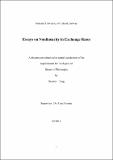| dc.description.abstract | This thesis consists of four essays that explore nonlinearity in three exchange rate-related issues: (1) the relationship between real exchange rates and economic fundamentals, (2) the predictability of exchange rate volatility, and (3) the effects on trade of exchange rate volatility.
The first essay explores the potential nonlinear cointegrating relationship between economic fundamentals and the real exchange rates of both the Chinese yuan and the Korean won over the period 1980-2009. The second essay aims to seek further evidence of nonlinear relationship by examining the real exchange rates of the euro and 10 former currencies of EMU member countries. The results show evidence of long-run nonlinear relationship between real exchange rates and fundamentals and evidence of nonlinear Granger causality from some economic fundamentals to the real exchange rates.
The third essay estimates and forecasts the volatility of four euro exchange rate series over the period 1999-2011 using ten volatility models. Besides confirming some established findings in the existing literature, this essay also provides some important new findings. First, the relative good performance of the regime-switching GARCH model implies that euro exchange rate volatility displays regime-switching characteristics. Second, FIGARCH.D performs the best among all the models over the volatile period after 2008. Third, GARCH models with a dummy variable for the volatile period generally perform better than those without a dummy over the volatile period.
The fourth essay explores how exchange rate volatility affects exports of ten EMU member countries. The results suggest that rising income of trading partners boosts exports, while real appreciation of the exchange rate and greater exchange rate volatility depresses exports. We also find that for some countries the adjustment of exports towards equilibrium follows an asymmetric nonlinear process. | en_US |


